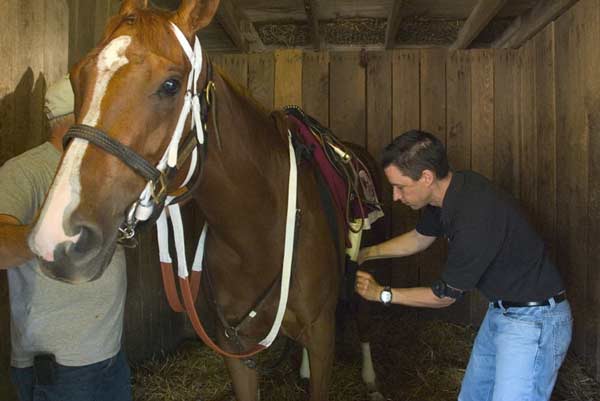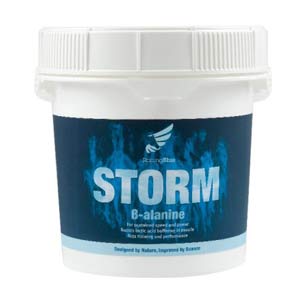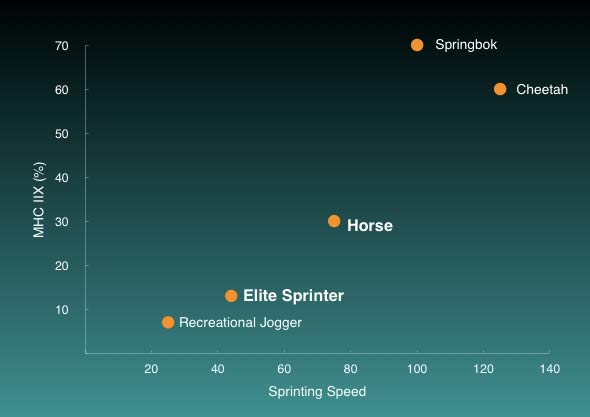
“Coach” Bill Pressey is a conditioning specialist for equine sports and is one of the shining stars in horse race training today. He owns a company that specializes in conditioning horses with solid sports science and in this interview shares some great insights from equine sports. California Chrome failed to win the Triple Crown (predicted by Pressey by the way) and there are many lessons to be learned by coaches who work with human athletes.
One of my favorite blogs can be found on Pressey’s website Thoro Edge Performance and some of the most state of the art technologies for athlete monitoring and sports medicine are actually coming from equine sports in Europe. In America, the use of technology and sport science is a bit behind with both athlete groups, but improvements from sharing can be ignited from information exchange. This interview explores what some of the best teams in the world are just starting to use and some of the approaches elite equine sport is doing over the last decade.
Technology and Monitoring with Horses
Freelap USA — Horse training is a favorite activity for some Olympic coaches. The athletes (horses) are very compliant but do have unique personalities. When looking at sports medicine, much of the work in the Netherlands is very progressive and looks at the strain of the animals with medical imaging and physiological monitoring. In stark contrast, some trainers do not even weigh their horses. What culture change do you think is necessary before we in the US and Canada can start evolving the sport?
Pressey — Trainers in the US (not sure about Canada) look at using any technological gear as a sign of “weakness”. As in this actual quote: “Sure that guy can use your help with HR gear, because he’s not a really good horseman.” These same people view an equine scale as a luxury item, and tout their ability to eyeball weight loss/gain as all that is needed. Essentially if their mentors 30+ years ago weren’t using HR, GPS, lactate, scales, etc., then they don’t need to either.
Carl’s Take — What is sad, is that an internal investigation with one high profile team in professional sports took two weeks to see if athletes got fat or came to into the season out of shape. Body composition isn’t exciting, but simple power to weight ratio, even if the changes are minor, are part of performance. I think the problem now is that very few can do both the Art and Science because not everyone is gifted in doing both at the same time very well.
Currently, Thermography is growing in momentum to help monitor overheating with athletes and to screen for possible soft tissue injuries. The reason equine sports is ahead of the curve is because reporting injury or pain by horses is impossible by verbal communication (no Mr. Ed jokes please) and creative solutions are needed to see how injuries are healing. Elastography and third party software to rapidly quantify healing is being used in the World Cup as we speak.
Running Mechanics and Heart Rate Concepts
Freelap USA — Your intensity zones show unique gait styles for horse locomotion when you are looking at HR and other parameters. People walk (with a double support heel-to-toe roll) and run (ranging from a jog to a sprint). Athletes have different running strides and movement patterns such as cutting, and strain on the lower extremity is as complicated as with horses. Instead of physiological monitoring, should we start adding the anatomical load to the analysis? GPS and accelerometers are not new, and equine sports have been using pressure mapping for lameness for a decade. Is it time for a paradigm shift in fatigue and repair of both human and horse athletes?
Pressey — Oh, I think such an analysis would be great, but it would need to be of practical use on the training track in a given morning, not merely in a lab on a treadmill. I know a human trainer looks at equine HR/GPS use and thinks – hell; they are 30+ years behind the human training curve, and they would be somewhat accurate. However, there is one big difference between human and equine athletic performances: humans are predators; horses are prey. As such, they are wired differently. Humans may take 45 sec to reach max HR, horses (even untrained ones) can do so in 6-10 seconds. Horses who are severely under-conditioned, and even slightly lame, can still win big races based purely on talent. I like to say that humans can train through fatigue and improve while horses training while fatigued often get injured. Most of what I do is try to pinpoint the onset of fatigue, and train up to that point – but not too far past.
I think it’s been said, certainly with respect to bodybuilders, that 99% of humans are overtrained. I would tend to agree with that. You tell a 16 yo kid to perform 6 – 100 yd sprints on his own, he may figure that 12 sprints are twice as good. We don’t have that problem with horses, although they do tend to ‘run off’ from a rider and go faster/further than is intended.

Figure 1: Team sports that are using GPS tools are trying to take advantage of the accelerometer to estimate load at different efforts (speeds and HR).
Carl’s Take — What I like about the zones above is that it includes the locomotive strategy of the horse on the right side of the zone chart (above left) is the biomechanical label included. Foot mechanics of human athletes should provide sufficient detail to map out possible kinetic chain injuries and recovery metrics if teams evolve more.
Countless teams share their use of brands when using heart rate monitoring, but it would be nice to post data during presentations instead of cartoons screenshots or flavor of the month book titles. With dozens of athletes training, how are coaches interpreting each player daily? Here is an excellent primer on heart rate monitoring and I suggest doing the basics before getting more advanced.
The Challenges with Drugs in Sport
Freelap USA — Drugs are a major part of elite sport. Equine doping literature shows that urine tests are used to detect neurotransmitter drug abuse in horses. With fatigue and pain being part of the brain, what do the trainers do to help keep horses motivated to compete when they don’t get the benefits that human athletes do? What are the emotional components that we should be looking at to create an environment that makes the equine athlete enjoying the purity of running? Is this beneficial to drug free competition with athletes in track and field or team sports?
Pressey — Think about this: equine sport is the only one in which females (or geldings) beat males every day of the week. So how important can male hormones be to equine performance? I think horses enjoy running if they are healthy and free from injury – and if they are being asked to gradually increase effort in training, rather than going through a threadbare exercise program and being tossed right into intense races. US horse racing is also one of the few sports worldwide where race day PED use is legal – as diuretic shots are even administered by racetrack personnel/veterinarians 4 hours prior to race time. Disgusting.
Carl’s Take — Sound Familiar? Athletes are breaking down because we are seeing a rise of pain medications and a decrease in training to prepare for sport. What is disgusting is that we are starting to see an increase in youth injuries from higher competition rates and LTAD is great on paper, but when parents think doing more sports is the answer, we are seeing kids underpreparing and over-competing, a vicious combination that is creating injuries that I have not seen in the last 15 years.
Another problem I am seeing is new diuretics with athletes to not only mask drugs, but to get lighter for “race day”. Add in stimulants and we are seeing a lot of cramping and fatigue that simply didn’t happen decades ago. If you look at some doping literature, it’s scary that drugs used for Parkinson’s disease are found in “legal amounts” in horse urine, something happening in elite track and field now. It seems that the dopers are skipping steps in adaptation with training and going straight to the buttons of the human body.
Beta Alanine and Supplementation
Freelap USA — Nutrition and supplementation are two areas that are still difficult to monitor with human athletes since their “stable” is away from the trainers. It was reported that California Chrome had a blood test a day or two before the big race day. Where do you see nutrition going to help create alternatives to Lasix? When you are creating a program for horses, how do you look at the fueling and feeding areas to ensure you are razor sharp for competition while still having the resources for training? Is their periodization in supplementation such as the STORM product?
Pressey — Supplementation is pretty basic in the horse racing world. I don’t comment too much on the concepts (other than STORM) because the equine digestive system doesn’t have a ton in common with humans. This type of knowledge is well above my pay grade! Chromes’ blood test is 1950’s style, only looking for signs of illness or infection. Routinely such tests score an A+ and a horse goes on to race in a disappointing fashion. Oh, how I wish we would do an exercise based lactate blood exam! How about galloping a mile in a pedestrian 2:00 and check for lactate? Number should be around 4.0 or less in a good horse. How does that number compare to last week? Before the last race? Etc. A goldmine of information….undiscovered.

Figure 2: Bill offers a great solution for horse trainers to get advantages legally with his STORM product. I have seen conflicting data with human sprint athletes regarding Beta Alanine.
Carl’s Take — Beta Alanine and other supplements are popular with some strength athletes but very few athletes are eating properly and those that do a better job with pills and not a fork and knife are fooling themselves. It seems like those that focus on supplements get caught in convenience approaches to nutrition as quick fixes. I have been doing advanced blood analysis for years, and those that are not doing an honest job with diet are exposed, even if they try to “beat the test” with last minute changes. Athletes will make smart choices on their own as the basics are reinforced, so I spend my time on making sure scheduling and planning are focused on, rather than talking about creating cycling or the latest sports drink.
New advancements in blood testing will make smartphone testing a reality, and the rise of this data will start to mine the gold Bill is speaking of.
Genetics, Durability, and better Conditioning
Freelap USA — Durability is an enormous area in elite sport, and it seems that from different readings, equine sport is dealing with fragility from overly cautious trainers, owners, and doctors. Besides genetics, could you describe how we need to stop looking at risk and start looking at adaptations and listening the pain of horses so they can heal? What are your thoughts about optimal loading and finding the sweet spot?
Pressey — Genetics is bunk, in my opinion. Every racehorse shares the genes of the same three foundation sires. Even the experts admit it has at most 30% to do with racing performance. Every racehorse has champions in his pedigree, the same ones nonetheless. Environment is where it’s at – and I am biased towards conditioning, of course.
Now that being said; horses being bred today were not trained like the champions of yesteryear, and they ALL race on legal race day medications such as Lasix and Bute. Back in the 1950’s champion horses went to the breeding shed after coming about their race day performances due to intense exercise regimens. That is what is to blame in my opinion – today’s sires are simply those horses who responded best to pharmaceuticals, not to exercise.
Carl’s Take — Obviously genetics matters, since we are not seeing a donkey dominate the Kentucky Derby, but it’s what you do with what you got. For all the talk about Antifragile we are still seeing athletes doing training programs that look like spa treatments. So elite sport is dealing with the same issues equine sports are facing, and hopefully in the future we can make changes to improve the entertainment and safety of both athlete populations.

Note: Bill emailed me a follow up point regarding the beta-alanine dissuasion. I included a chart to show the difference between horses and humans as another species to compare to can start guiding us to why some athletes are non-responders to supplements.
Pressey — One (interesting) point of clarification regarding beta-alanine. Humans typically have 8% carnosine concentrations in skeletal muscle, but horses have closer to 30% – making beta alanine, histidine, and the resulting carnosine 400% more important to horses than humans. Doesn’t surprise me that studies with humans have conflicting results. If anyone ever does a study on horses they will be shocked at the correlations. However, such a study has many obstacles.
Makes sense when you realize that horses are prey, and nature must equip them with a mechanism to fight or flight that may be necessary several times a day.
Please share this article so others may benefit.
[mashshare]


Will this product help with muscle oxidative stress my horse has high levels of CK. AST GGT and possible low gulusce levels